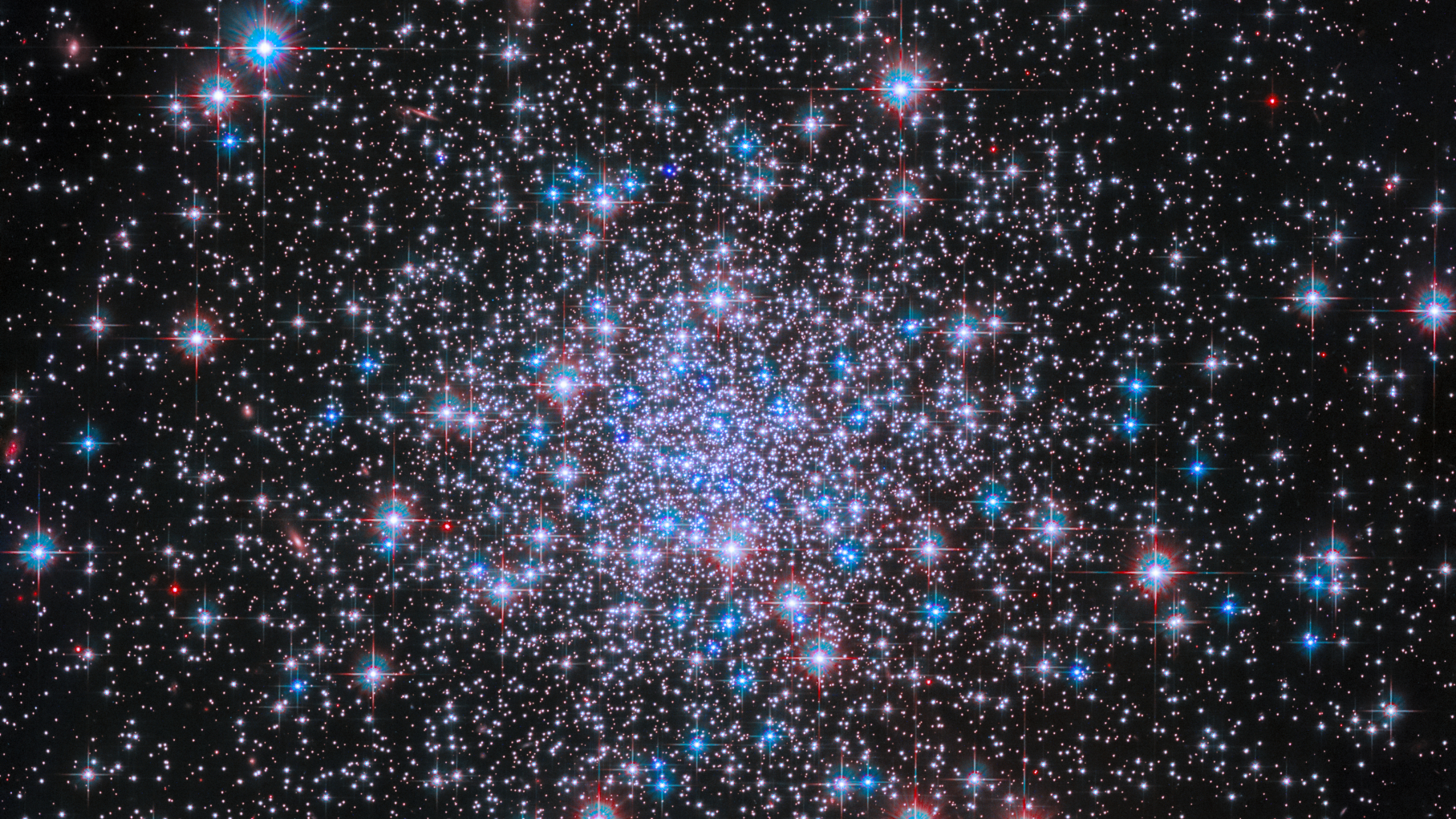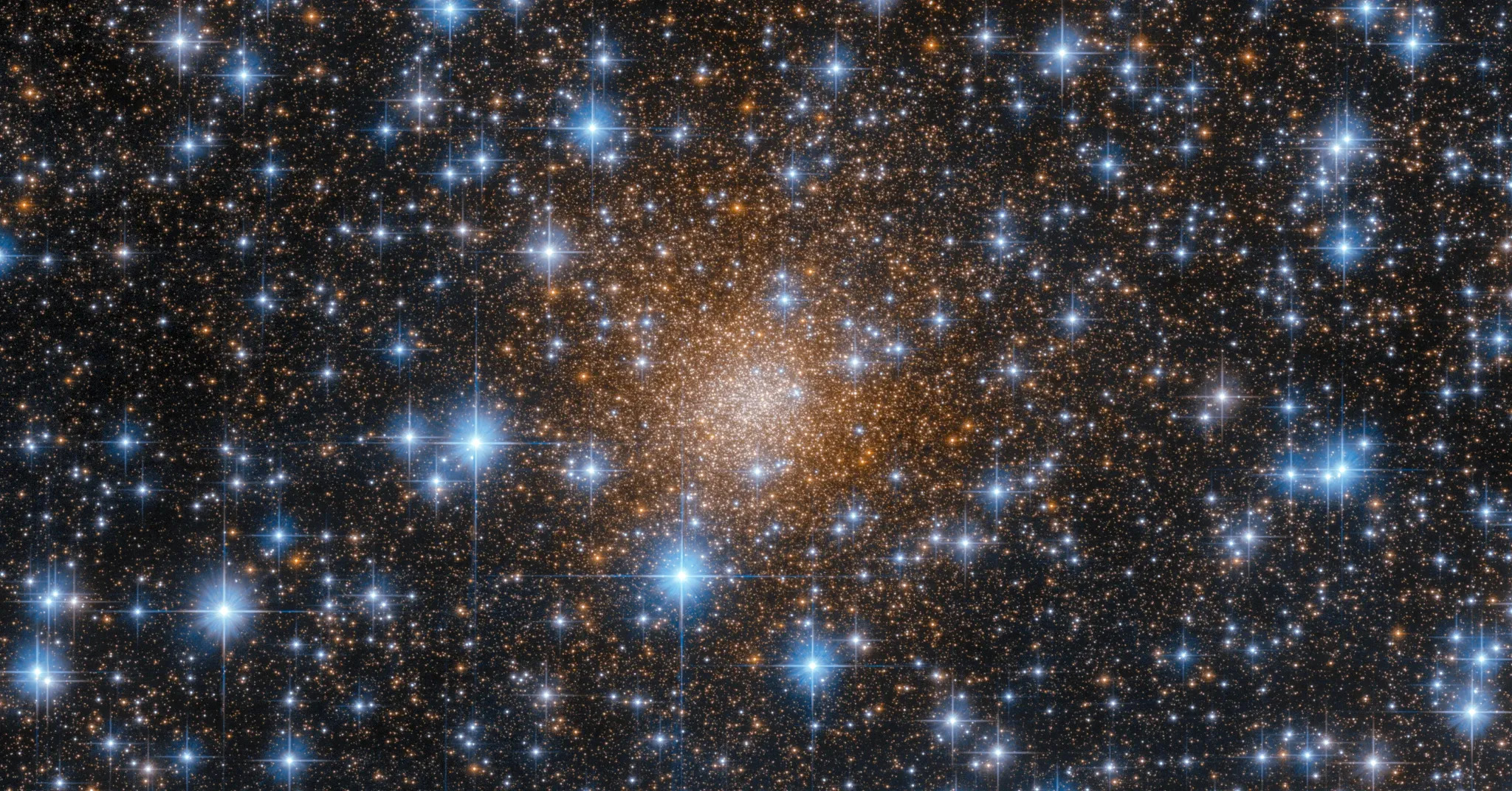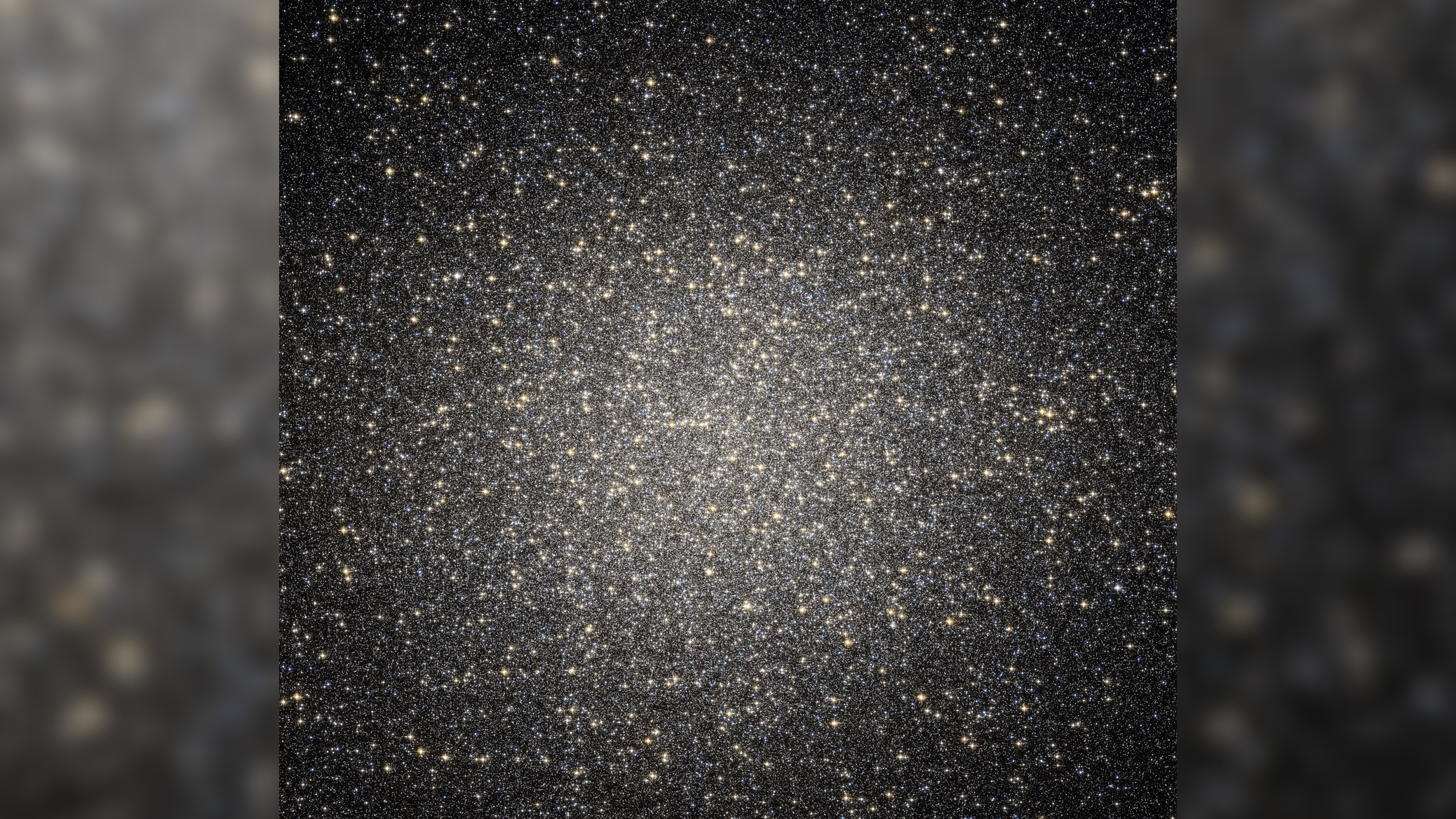
Globular clusters are dense, symmetrical regions of stars.
They typically reside in the extended stellar halos, or outer regions, of their home galaxies. They can be composed of a few thousand stars or up to tens of millions of stars.
Globular clusters house some of the oldest stars in any given galaxy. Astronomers know this because a significant number of stars within globular clusters have very low metallicity, or metal content, which means they were formed before generations of stars had synthesized large quantities of heavy elements and scattered them throughout the cosmos.
While globular clusters can span hundreds of light-years, they are still dwarfed by their home galaxies, which are usually tens to hundreds of thousands of light-years across. The Milky Way, for instance, is known to contain 158 globular clusters.
That number is likely to increase, however, as a significant portion of our view of the Milky Way is obstructed by dense regions of gas and dust. New optical instruments such as the James Webb Space Telescope (JWST) and the Nancy Grace Roman Space Telescope, with their infrared capabilities, will be able to peer through these regions, giving astronomers a new perspective on these bustling stellar communities.
Related: Globular cluster glitters in stunning Hubble telescope photo
Globular clusters FAQs
What is a globular cluster?
Globular clusters are some of the densest regions of stars in the sky. Living on the outskirts of their home galaxies, globular clusters can be home to tens of millions of stars, some of which are the oldest in their home galaxies.
Is a globular cluster bigger than a galaxy?
Globular clusters can be massive, but they pale in comparison to their home galaxies. While a large globular cluster might house tens of millions of stars, galaxies are often home to billions of stars.

What globular cluster is closest to Earth?
Messier 4, or M4, is the closest known globular cluster to Earth. The cluster sits just 5,500 light-years from Earth.
Omega Centauri
Omega Centauri is one of the largest globular clusters in the Milky Way. Astronomers think it contains roughly 10 million stars. It has a diameter of 150 light-years and sits 17,000 light-years from Earth.
The gigantic cluster can be seen with the naked eye from Earth year-round in the Southern Hemisphere and, for parts of the year, in the Northern Hemisphere. The cluster sits roughly in the center of the constellation Centaurus and It shines at a magnitude of 3.9. With unaided vision, it looks like a fuzzy star, but with a telescope, the cluster appears in all its sparkling glory.

Omega Centauri contains a range of stars of varying ages, and this diversity has somewhat perplexed astronomers. One exciting possibility is that Omega Centauri is the remnant core of an ancient galaxy that was swallowed and absorbed by the Milky Way.
In a 2018 paper, scientists speculated about the potential habitability of worlds in Omega Centauri or what constraints life might face if it were to emerge on a planetary body in such a dense stellar region. The authors argued that any planets orbiting in the habitable zones of stars in Omega Centauri would likely be disrupted by close encounters with other stellar bodies within the cluster.
In 2008, astronomers detected a possible medium-size black hole in the center of Omega Centauri. Although the black hole is considered "medium size," its mass is thought to be an astonishing 40,000 times the mass of the sun. The existence of the black hole in Omega Centauri's core lends support to the idea that the cluster may be the remnants of an ancient galaxy's core.
Globular cluster expert Q&A
We spoke to Dominic Benford, the Program Scientist for the Nancy Grace Roman Space Telescope some questions about globular clusters.
Globular clusters are usually composed of old stars. What do we know about the conditions in young galaxies that led globular clusters to form?
Globular clusters do tend to be composed of old stars, but not entirely. Some of them (e.g., Omega Centauri) have a mix of stars of different ages, implying that there are episodes of star formation within the cluster over billions of years. But yes, the oldest generation of stars can be around 13 billion years old (e.g., M30), close to the age of the universe, at roughly 13.7 billion years. In contrast, some are only half that age (e.g., Palomar 1).
Having multiple populations of stars in a single globular cluster or any set of globular clusters makes them more interesting and diverse objects to study, since each is a little like a tiny galaxy within our own (or within a nearby galaxy). There is evidence for things like black holes in the centers of globular clusters (e.g., M4), just like in the centers of galaxies. Also, some globular clusters may be the remnants of dwarf galaxies being absorbed by the Milky Way, such as Laevens 1 (which is out in the halo of our galaxy, at something like 20% of the distance to the Andromeda galaxy). And some may have formed as cast-offs from the formation of the Milky Way itself (e.g., Terzan 5).
Omega Centauri is referred to as the largest globular cluster (that we know of) in the Milky Way. What are some interesting things we have learned about Omega Centauri?
It's pretty likely that Omega Centauri is the largest globular cluster in the Milky Way. At 10 million stars, it's much bigger than most, which have more like a million stars. Also, it has multiple populations in it and possibly a central black hole. It may be that Omega Centauri is a dwarf galaxy that is in the early stages of being absorbed by the Milky Way. Some of its stars may be getting stripped away, like Kapteyn's star. We've even named the stars being pulled out — "the Fimbulthul stream."
While Omega Centauri is probably the largest globular cluster in the Milky Way, that doesn't mean it's the largest one we know of. For instance, our nearby neighbor the Andromeda galaxy has a globular cluster, Mayall II, orbiting it — and this cluster is twice the size of Omega Centauri!
How will new tools, such as the Nancy Grace Roman Space Telescope, help advance our understanding of globular clusters?
The Nancy Grace Roman Space Telescope is designed to have revolutionary capabilities to enable astronomers to study the universe more efficiently than ever before. It has an enormous, 300-megapixel infrared camera with multiple infrared filters to allow it to take multicolor pictures of the universe with a field of view a hundred times greater than the Hubble Space Telescope. It has the same sharp images and same sensitivity as Hubble but can move to take new pictures far faster, so that surveying the sky with Roman is up to a thousand times faster than surveying with Hubble!
If you look at the full moon, it's about half a degree across. That's roughly the size picture you would have to take to capture the full extent of a typical globular cluster like M55. (Omega Centauri and 47 Tucanae are up to twice this size.) The camera on Hubble has a field of view around 1/62 of the size of the full moon, so it would take dozens of individual pictures to capture the entirety of a globular cluster.
The camera on Roman has a field of view 43% larger than the full moon, so you can image a whole cluster in one picture! This wide field of view allows Roman to study the fainter, typically lower-mass stars that inhabit the outer reaches of globular clusters and which are therefore poorly studied by smaller-field images. Plus, Roman's wavelength coverage extends further into the infrared than Hubble's, so [it] can see through more of the dust in the Milky Way and gain more information on the fainter, redder stars that Hubble can't see so easily.
One other power of Roman is that it can measure the positions of stars extremely precisely. If we observe a globular cluster now, and then in a few years, and then again a few years later, we can easily see the stars moving inside the cluster. This tells us about the internal structure and how the cluster is evolving. It can also show us how the cluster as a whole is moving in the Milky Way and let us place how it is merging with our galaxy (or perhaps has long ago merged with our galaxy).
Is it possible that there are other, yet-unseen globular clusters in the Milky Way hidden behind dust and gas? Might galactic surveys help us spot them?
Oh, definitely. Globular clusters are still being discovered in the Milky Way and its halo. Some are behind the clouds of gas and dust in the plane of our galaxy and so can only be found using infrared light, which penetrates dust much more effectively than visible light. The cluster Mercer 3 is a good example of this; it was discovered only in 2008 and has a visual "extinction" (how much fainter the visible light is due to absorption by dust) of more than a billion times!
Roman's infrared wavelengths, coupled with its exquisite sensitivity and angular resolution, make it very well suited to finding many new globular clusters hidden in our galaxy. In fact, we recently added a [Galactic Roman Infrared] Plane Survey as one of the major surveys the telescope will undertake, and it should certainly discover new globular clusters.
Other clusters may have escaped detection because they are far outside the galaxy and small, and so they're very faint (e.g., William 1). Roman will be good at finding these, since it can cover a wide area of the sky and pick up small, low-brightness clumps of stars like this. It's hard to predict how many Roman will find, since we don't really know how many are out there!
Does learning more about globular clusters help us understand the evolution of galaxies?
One of the greatest stories yet to be fully told is how galaxies assemble. We see around us a host of galaxies with billions of stars. But how did they get here, and how did they combine to form the shapes we so often see (for instance, spiral galaxies)? Astronomers believe that galaxies grow in part by gathering gas into clumps, which form some stars, and which then combine into bigger clumps, which then merge and so on … until you have a giant galaxy like our own.
In that process, there are globular clusters which form in one galaxy and then are separated and incorporated into the merged galaxy. We know of several, such as NGC 2298 (which formed in a dwarf galaxy) and M54 (which is probably still in its dwarf galaxy, currently being consumed by the Milky Way). Since this process happens so slowly, we can't watch it progress; instead, we have to look at different globular clusters at different points in their absorption into the Milky Way or nearby galaxies.
The Nancy Grace Roman Space Telescope will be able to survey perhaps a hundred nearby galaxies to find the dwarf galaxies and globular clusters orbiting them, so the total number of globular clusters we know [of] may increase many times over. This wealth of new information should prove immensely valuable to astronomers who want to understand how galaxies like our own came to be.
Additional resources
If you're interested in seeing some images of a nearby globular cluster in all its globular glory then check out some of these images taken by the European Space Agency's Euclid Space Telescope. The cluster in question is called NGC 6397, which also happens to be the second closest globular cluster to our solar system. For discussions about the distribution and formation of globular clusters, read this press release from researchers who investigated where these clusters typically reside from Harvard. For further fascinating discussion about the possibility of life, and even intelligent civilizations residing in globular clusters, then check out this press release, again, from researchers from Harvard.
Bibliography
Alessandro Paduano et al. (2024). Ultradeep ATCA Imaging of 47 Tucanae Reveals a Central Compact Radio Source. ApJ 961 54
Blazer, A. (2021, March 03). New ‘Eyewear’ to Deepen the View of NASA’s Roman Space Telescope. NASA. https://www.nasa.gov/missions/roman-space-telescope/new-eyewear-to-deepen-the-view-of-nasas-roman-space-telescope
Blome, C. (2024, January 07). NASA’s Roman to Search for Signs of Dark Matter Clumps. NASA. https://www.nasa.gov/missions/roman-space-telescope/nasas-roman-to-search-for-signs-of-dark-matter-clumps
Britannica. Omega Centauri. https://www.britannica.com/place/Omega-Centauri
Harvard & Smithsonian. (2016, November 03). The Distribution of Globular Clusters. https://pweb.cfa.harvard.edu/news/distribution-globular-clusters
Harvard & Smithsonian. (2016, July 01). Globular Clusters Could Nurture Interstellar Civilizations. https://pweb.cfa.harvard.edu/news/globular-clusters-could-nurture-interstellar-civilizations
NASA Hubble Mission Team. (2008, April 01). NASA – Astronomers Find Suspected Medium-Size Black Hole in Omega Centauri. NASA. https://science.nasa.gov/missions/hubble/nasa-astronomers-find-suspected-medium-size-black-hole-in-omega-centauri/
Roman Space Telescope. Continuing the Legacy of NASA’s Great Observatories The Nancy Grace Roman Space Telescope. https://www.stsci.edu/files/live/sites/www/files/home/roman/_documents/roman-science-sheet.pdf
R. D'Abrusco et al. (2016). The extended spatial distribution of globular clusters in the core of the Fornax Galaxy. ApJL 819 L31. DOI 10.3847/2041-8205/819/2/L31
Søren S. Larsen et al., (2020). An extremely metal-deficient globular cluster in the Andromeda Galaxy. Science 370,970-973(2020). DOI: 10.1126/science.abb1970
Stephen R. Kane and Sarah J. Deveny. (2018). Habitability in the Omega Centauri Cluster. ApJ 864 115
The European Space Agency. (2019, July 22). A puzzle of 10 million stars. https://www.esa.int/ESA_Multimedia/Images/2019/07/A_puzzle_of_10_million_stars
The European Space Agency. (2023, November 07). Euclid’s view of globular cluster NGC 6397. https://www.esa.int/Science_Exploration/Space_Science/Euclid/Euclid_s_view_of_globular_cluster_NGC_6397







